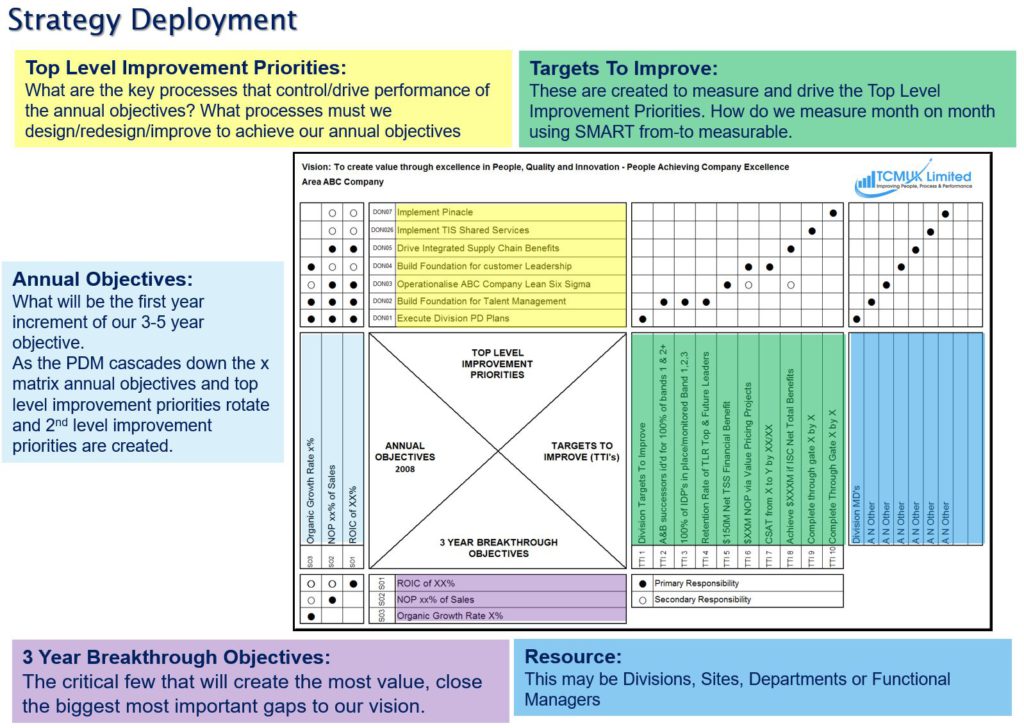
From Friction to Flawless Execution: Unifying Your Teams with the X Matrix
Have you ever seen it? The classic standoff. The sales director, beaming, walks back into the office having just landed a massive, company-changing order. High fives all around. Then they walk over to the production manager to share the good news, and the beaming smile is met with a stone-cold stare. The production manager’s first question isn’t “How much revenue is that?” but “When do they need it by? Do you have any idea what this does to our current schedule?”
In a flash, the celebration is over. It’s not one team winning; it’s two departments bracing for a fight.
This, right here, is the quiet killer in so many manufacturing businesses. We call them departmental silos. They’re the invisible walls that spring up between sales, production, engineering, finance, and quality control. Everyone is working hard, everyone is trying to hit their numbers, but they’re not working together. It leads to friction, wasted effort, missed deadlines, and a general feeling of us versus them. To be honest, it’s exhausting for everyone involved.
The problem isn’t usually the people. It’s the system. Or rather, the lack of one. The root of the issue is that each department is playing its own game with its own scoreboard. What if, instead, everyone in the company could see the same game plan, understood their specific role in it, and shared the same scoreboard? That’s what we’re going to talk about. We’ll explore how creating visible, shared objectives, using a powerful but practical framework like the X Matrix, can dismantle those silos and turn competing teams into a single, unstoppable execution force.
The Real Cost of Departmental Silos
Let’s be real for a moment. What do silos actually look like on a Tuesday afternoon in a busy manufacturing plant? It’s not just a theoretical concept; it’s a series of small, frustrating moments that add up to a big problem.
It’s the engineering team spending months perfecting a new product design, only to find out from production that it’s a nightmare to manufacture efficiently, requiring costly new tooling that wasn’t budgeted for.
It’s the finance department chasing the sales team for forecasts, while the sales team is chasing production for lead times, and production is blaming procurement for material delays. It’s a circular firing squad of emails and excuses.
I remember visiting a factory a few years back where the quality team had implemented a new, rigorous inspection process. They were proud of it, and their metrics for ‘defects caught’ went through the roof. The problem? It created a massive bottleneck at the end of the production line. On-time delivery numbers plummeted, and the production team was furious. The quality team hit their goal, but the company, as a whole, failed the customer. Both teams were doing their jobs as they understood them, but they were working at cross purposes.
This isn’t just inefficient; it’s corrosive to your company culture. It breeds a “not my job” mentality. People stop thinking about what’s best for the business and start thinking about how to protect their own patch. Morale takes a nosedive because nobody enjoys coming to work feeling like they’re in a constant battle with their own colleagues. Good people, the ones who want to collaborate and solve problems, eventually get fed up and leave.
So where does this all come from? It’s rarely intentional. It’s the natural result of a few common things:
- Isolated Goals: Sales is bonused on revenue. Production is measured on cost per unit and efficiency. Finance is focused on cash flow. When these goals aren’t explicitly linked, they will inevitably conflict.
- Unclear Company Vision: If the leadership hasn’t clearly and repeatedly communicated the top 3 to 5 priorities for the entire year, departments are left to invent their own. And they will, based on what seems most important from their limited perspective.
- Limited Communication: There’s no regular, structured forum for different team leaders to get together, review progress against a shared plan, and solve cross-functional problems. The weekly production meeting doesn’t count if sales and engineering aren’t there.
Silos aren’t a sign of bad people. They’re a sign of a disconnected strategy. The cost isn’t just in lost efficiency; it’s in lost potential, lost morale, and ultimately, lost customers.
The Case for Shared Objectives
So, what’s the alternative to this siloed chaos? It’s deceptively simple in concept: get everyone aiming at the same target. Think of your business as a rowing team. If the person in the front is rowing towards the left bank, and the person in the back is rowing towards the right, you’re just going to spin in circles and get very tired. The only way to move forward, fast, is for everyone to row in the same direction, in perfect sync.
Shared objectives are your common direction. They create a clear line of sight from the highest-level strategic goals of the company right down to the daily tasks of an individual on the shop floor.
This is where so many businesses stumble. The owner or managing director has a brilliant three-year plan in their head—maybe it’s to expand into a new market, increase profitability by 20%, or become the number one supplier in a specific niche. But that vision stays in the boardroom. It never gets translated into meaningful, tangible goals for the people who actually make, sell, and ship the product.
A truly aligned organisation makes that connection explicit. The process looks something like this:
- Company Strategic Goal: Increase market share in the North of England by 15% in three years.
- Annual Company Objective: Launch Product X, which is tailored for the northern market, and secure 10 flagship clients this year.
- Sales Department KPI: Secure £500,000 in sales for Product X from the target region.
- Production Department KPI: Achieve a 98% on-time, in-full delivery rate for Product X and maintain a specific cost per unit.
- Engineering Department KPI: Finalise the Product X design and support production to resolve any manufacturing issues within 24 hours.
Do you see the difference? Suddenly, the goals aren’t in conflict. For the company to win, Sales, Production, and Engineering all have to succeed, and their success is now visibly interconnected. The sales team knows that promising unrealistic delivery dates will hurt production’s ability to hit their target, which ultimately hurts everyone. Production understands that keeping costs down on Product X helps sales be more competitive, which helps everyone.
When objectives are shared and visible, the conversation changes. It shifts from “That’s your problem” to “How can we solve this together?” It clarifies priorities. When a new request comes in, you can ask a simple question: “Does this help us achieve our shared objective of launching Product X successfully?” If the answer is no, it becomes much easier to say no, or to at least question its urgency. It gives your teams a framework for making smart decisions without needing constant supervision.
X Matrix: A Practical Tool for Breaking Down Silos
Okay, so the idea of shared goals is great. But how do you actually manage it without creating a mountain of spreadsheets and confusing documents? This is where a tool like the Hoshin Kanri X Matrix comes in.
Now, don’t let the name intimidate you. It sounds complex, but at its heart, the X Matrix is just a powerful one-page plan that shows the connections between your long-term vision, your annual goals, your key projects, and the metrics you use to measure success. It’s a visual map that everyone in the business can understand.
Imagine a large square divided into four quadrants, with a space in the middle:
- South Quadrant (Bottom): Long-Term Objectives. This is your “True North.” Where do you want the business to be in 3 to 5 years? These are the big, strategic ambitions. For example: “Become the UK’s most trusted supplier of high tolerance components” or “Achieve carbon-neutral operations.”
- West Quadrant (Left): Annual Objectives. What do we need to accomplish this year to make progress towards our long-term vision? These are more specific and time-bound. Things like: “Reduce overall waste by 10%,” “Increase on-time delivery from 92% to 97%,” or “Launch our new e-commerce platform.”
- North Quadrant (Top): Top Improvement Priorities. These are the key projects or initiatives you will execute this year to achieve your annual objectives. Think of them as the “how.” For example: “Implement 5S across the factory floor,” “Renegotiate contracts with top 3 suppliers,” or “Train sales team on new CRM software.”
- East Quadrant (Right): Metrics to Measure. How will you know if you are winning? These are the key performance indicators (KPIs) that track your progress. Things like “Customer satisfaction score,” “Scrap rate,” “Sales conversion rate,” or “Employee turnover.”
- Far East (Far Right): Ownership. This is crucial. For every top priority and every key metric, you assign a name. Who is responsible for driving this forward? Accountability becomes crystal clear.

The real power of the X Matrix is in the corners and the centre. This is where you use dots or check marks to show the relationships. You can see exactly which Top Priorities (North) support which Annual Objectives (West). You can see which Annual Objectives link to which Long-Term Goals (South). You can see which Metrics (East) are measuring the success of your priorities.
It forces the critical conversations that break down silos. When you build the matrix as a leadership team, the sales director can see that the “Implement 5S” project isn’t just a tidy-up exercise for production; it’s a critical enabler for reducing lead times, which directly impacts the “Increase on-time delivery” objective that the sales team cares so much about. Everything is connected, and for the first time, everyone can see those connections on a single sheet of paper.
Building Cross-Functional Collaboration
Having a beautiful X Matrix on the wall is a great start, but it’s just a tool. It’s like having a detailed map but never actually starting the journey. The tool only works if you build the right behaviours and rhythms of communication around it. This is about bringing the plan to life.
Here are a few essential enablers for making this work in the real world:
- Regular Cross-Team Reviews: The plan is not static. You need a regular heartbeat of accountability. This often takes the form of a monthly or quarterly business review. The key is that this isn’t a series of separate departmental updates. It’s one meeting where leaders from every department review the same plan—the X Matrix. You go through the key metrics. Are they green, amber, or red? If a metric is red, the conversation isn’t about whose fault it is. It’s about which cross-functional priorities are behind schedule and what help is needed to get them back on track.
- Transparent Communication Channels: Everyone should be able to see the score. Modern manufacturers use simple digital dashboards—they can be built in Excel, Google Sheets, or more advanced tools like Power BI. These dashboards display the key metrics from the X Matrix in real time, or close to it. When the on-time delivery metric is visible on a screen on the shop floor and on the sales director’s laptop, it becomes a shared reality. There’s no hiding from the data.
- Collaborative Training: Don’t just train your teams in their functional skills. Invest in training that brings different departments together. A workshop on Lean principles or problem-solving that includes people from sales, finance, and production can be revolutionary. They start to understand each other’s challenges and learn a common language for improvement. They build personal relationships that make it much easier to pick up the phone and solve a problem later on.
- Leadership That Models the Way: This might be the most important piece of the puzzle. If the department heads and senior leaders are seen to be collaborating, challenging each other respectfully, and focusing on the shared objectives, the rest of the organisation will follow. But if they leave the strategy meeting and go back to protecting their own turf, the entire effort will fail. Leaders must consistently use the X Matrix to frame their decisions and communications. They must walk the talk, every single day.
Real World Impact: From Friction to Flow
Let me tell you about a fictional but very typical company: Midlands Precision Engineering. They were a 50-person firm, good at what they did, but stuck. Growth had stalled. Their biggest problem was internal friction. Sales would promise custom jobs with short lead times to win business, which would throw the production schedule into chaos. Production would then cut corners to catch up, leading to quality escapes. The quality team would then clamp down, slowing everything down again. It was a vicious cycle.
They decided to try a new approach. The leadership team spent two days building their first X Matrix. For the first time, they had a heated but productive debate about what truly mattered for the business over the next three years. They agreed on three long-term goals: being the number one choice for quality, achieving 99% on-time delivery, and growing the business by 50%.
From there, they defined their annual objectives and the key projects to get there. One of the top priorities was to create a formal “Sales, Inventory, and Operations Planning” (SIOP) process. This project was co-owned by the heads of Sales and Operations.
What happened? The monthly SIOP meeting became the place where they made promises together. Sales brought their forecast. Production brought their capacity plan. They looked at the data together and agreed on a plan for the next three months. Sales now understood the real constraints of the factory, and production got a much earlier view of demand, allowing them to plan materials and labour more effectively.
Within a year, their on-time delivery had jumped from 85% to 97%. Quality issues dropped because the frantic, last-minute rush jobs became the exception, not the rule. And because they were now a more reliable supplier, they started winning more profitable, long-term contracts. Morale improved dramatically because people were no longer fighting fires; they were working together towards a clear, common goal. The X Matrix didn’t magically solve their problems, but it gave them the map and the compass they needed to solve them together.
Your Next Move
We’ve covered a lot of ground, but the core message is simple. Departmental silos are the default setting in most growing businesses, but they don’t have to be your reality. The antidote is to make your strategy visible, make your objectives shared, and make your teams interconnected. You stop managing departments and start leading a single, unified business.
Frameworks like the X Matrix provide a practical, proven way to do this. They move your strategic plan from a document gathering dust on a shelf to a living, breathing tool that guides daily decisions and fosters genuine collaboration. It’s not about adding more management layers or bureaucracy. It’s about creating clarity, alignment, and accountability. It’s about getting all your best people rowing in the same direction.
If this sounds like the kind of clarity and alignment you’ve been looking for to unlock your business’s true potential, then it might be time to take the next step. To see how these principles can be applied directly to your organisation, I’d encourage you to explore the Goal Deployment Programme at https://tcmuklimited.co.uk/goal-deployment-programme/. It’s designed to help manufacturers like you make this transition from theory to reality.
More Blog Posts







To leave me a message or book a return call at a time that suits you








